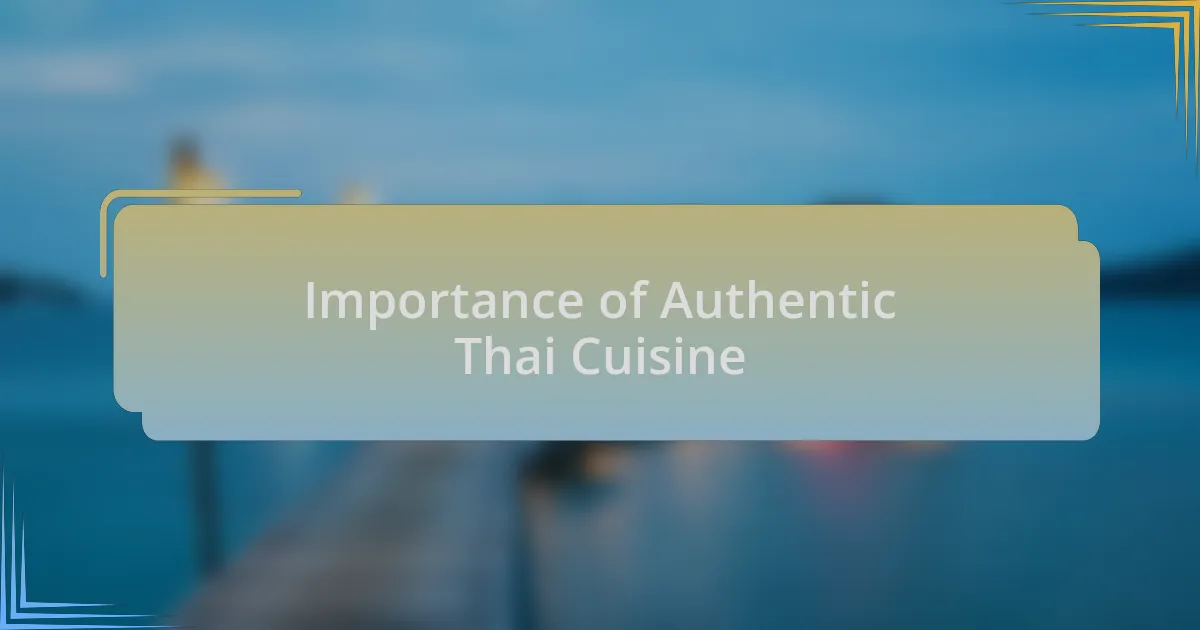Key takeaways:
- Thai dinner parties emphasize cultural connection and the joy of sharing diverse flavors that encourage conversation and memory-making.
- Authentic Thai cuisine relies on the right blend of fresh ingredients, capturing the essence of Thai culture and enhancing the dining experience.
- Creating a perfect Thai menu involves balancing flavors, visual appeal, and incorporating unique personal favorites to surprise guests.
- Essential ingredients like fresh herbs, lemongrass, fish sauce, and tamarind paste are crucial in achieving the vibrant taste characteristic of Thai dishes.

Introduction to Thai Dinner Parties
Thai dinner parties are a delightful fusion of culture, flavor, and communal spirit. I vividly remember my first experience hosting one; the aromas of fresh herbs and spices filled my home, instantly transporting my guests to Thailand. Do you ever wonder how the right blend of flavors can create such a warm and inviting atmosphere?
The essence of a Thai dinner party lies not just in the food but in the joy of gathering. Each dish tells a story, whether it’s the tangy freshness of a green papaya salad or the fragrant warmth of a red curry. I often find that sharing a meal like this invites conversation and connection; have you noticed how food can spark memories and laughter among friends?
Preparation for a Thai dinner party can feel like a culinary adventure. I still get excited selecting ingredients at the market, imagining the vibrant colors of the dishes coming together on the table. It’s more than just cooking; it’s about creating an experience that lingers long after the last bite, don’t you think?

Importance of Authentic Thai Cuisine
Authentic Thai cuisine is vital not only for the flavors it delivers but also for the cultural experiences it encapsulates. I recall a time when I hosted a dinner party featuring homemade Pad Thai; every bite echoed the bustling street food stalls of Bangkok. Have you ever tasted something that instantly transported you to another place? That’s the magic of authentic dishes.
The vibrant balance of sweet, sour, salty, and spicy in Thai cooking creates a symphony of flavors that I believe is unmatched. Each ingredient plays a role, and when I use traditional methods and recipes, I can almost hear the laughter and chatter of my friends as we enjoy our meal. It’s a reminder that food is more than sustenance; it’s a bridge connecting us to a rich cultural heritage.
When I think about authentic Thai cuisine, I’m reminded of the importance of sourcing fresh ingredients, as they truly make a difference. I have made it a point to visit local Asian markets, where I’ve developed relationships with vendors who share their tips and stories about the food. Isn’t it incredible how these connections add depth to our culinary experiences?

Planning the Perfect Thai Menu
Planning a perfect Thai menu starts with understanding the balance of flavors that define the cuisine. When I prepare a menu for my dinner parties, I always consider including a variety of dishes that highlight the quintessential sweet, sour, salty, and spicy notes. Just last month, I included a tangy som tum (green papaya salad) alongside a rich and creamy massaman curry, which really sparked lively conversations among my guests. Have you ever noticed how certain dishes can become conversation starters?
In my experience, setting the right tone for the meal also means paying attention to the visual appeal and aroma. I often arrange the dishes in vibrant colors, as this not only pleases the eye but also builds anticipation. I remember showcasing a beautifully plated tom yum soup, and as its fragrant steam wafted through the room, it drew gasps of excitement from my friends. Can you think of a time when the sight or smell of food made your mouth water?
I find it essential to not only stick to traditional recipes but also to incorporate some personal favorites that might surprise my guests. For instance, I once added a playful mango sticky rice dessert—an always crowd-pleaser. It’s about that element of surprise and delight that turns a simple gathering into an unforgettable experience. So, what unique twists could you bring to your Thai menu that would wow your guests?

Essential Ingredients for Thai Dishes
When crafting Thai dishes, there are some essential ingredients that truly make each meal come alive. Fresh herbs like cilantro and basil are non-negotiables for me; they add a vibrant aromatic touch that transforms the simplest dishes into a flavor explosion. I recall infusing my last pad Thai with a generous handful of fresh lime leaves, and the aroma alone had everyone asking for the recipe. Have you ever tasted a dish that instantly transported you to another place?
Lemongrass is another standout ingredient that I can’t overlook. It infuses a unique citrusy punch that’s absolutely essential in soups and curries. I remember experimenting with it in a tom kha gai (chicken coconut soup) and feeling that delightful warmth spread across my kitchen. What is it about certain scents that can evoke such powerful memories and feelings?
Balancing ingredients is key, especially with the potent fish sauce and tamarind paste. I often emphasize this when hosting dinner parties, as they harmonize the salty and sour notes that characterize Thai cuisine. Just last week, a friend dared to taste my homemade som tum, and the blend of flavors was so striking that it sparked a heated debate on whether it could rival any Thai street vendor’s version. What blends of flavor have left a lasting impression on you?